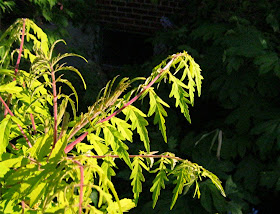
 I know the flower is Glaucium grandiflorum, Red Horned-Poppy, from Annie's Annuals and Perennials. I love all Horned-Poppies, all red/orange flowers, large unique fruits, and all grey foliage so this plant really works for me. Plus it's happy with the suuny sand in the front garden. Wow. I expect though, that it's one of those "short-lived" plants so I'll need to propagate it. I think I'll collect seed; that way I'll have enough to give plants away.
I know the flower is Glaucium grandiflorum, Red Horned-Poppy, from Annie's Annuals and Perennials. I love all Horned-Poppies, all red/orange flowers, large unique fruits, and all grey foliage so this plant really works for me. Plus it's happy with the suuny sand in the front garden. Wow. I expect though, that it's one of those "short-lived" plants so I'll need to propagate it. I think I'll collect seed; that way I'll have enough to give plants away.I don't really know what the bottom growths are but they do look reminiscent of the Cedar Apple Rust teliospores on Juniperus. It's some stage of a rust life cycle. I'm not that embarrassed at not being able to identify the fungus; it's humbling though, that an evergreen broad-leafed xerophyte has been in my garden for over a year and I have no idea what it is! And apparently no record of planting it. I guess it'll flower this year, if the rust doesn't kill it, and become identifiable. Isn't it wonderful that a 120$ camera can double as a microscope? Actually I took this picture on the stage of my dissecting microscope; the light is strong and well colored.

































